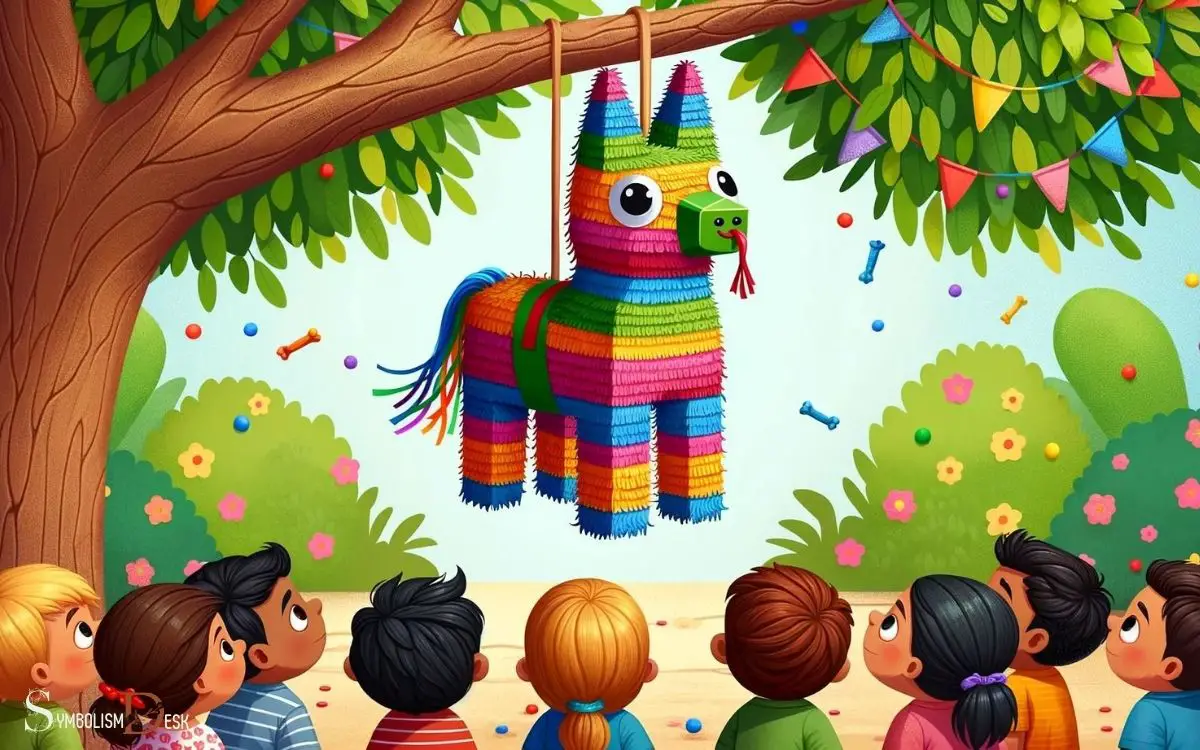What is the Symbolic Meaning of the Pinata? Evil!
The piñata is a symbol of joy and celebration, often representing the struggle between good and evil, the triumph of faith, and the abundance of rewards for virtuous behavior. The piñata traditionally has a rich history rooted in religious and cultural significance.
Its design and the act of breaking it are steeped in symbolism:
- Religious Symbolism: Originally, piñatas were used in religious ceremonies to represent the struggle against temptation and evil.
- Seven Deadly Sins: The classic seven-pointed star piñata is said to symbolize the seven deadly sins, with each cone representing one sin.
- The Act of Breaking: When the piñata is broken, it signifies the breaking away from sins or evil, releasing the good (candy or fruit) inside.
- Blindfold: The use of a blindfold while hitting the piñata is interpreted as faith overcoming temptation or evil through blind faith.
- Colorful Decoration: The vibrant colors and decorations are symbolic of the joys and temptations of life that one must overcome.
Piñatas embody the essence of festivity, where each swing is a dance with tradition, culminating in a shower of sweet victory.

Key Takeaway
6 Symbolic Aspects of Pinatas
| Symbolic Aspect | Meaning |
|---|---|
| The Shape | Piñatas often have seven pointed cones, symbolizing the seven deadly sins. Different shapes could also be used, each having its own significance. |
| The Colors | The brightly colored paper covering the piñata symbolizes temptation, appealing to people’s desires. |
| The Blindfold | The blindfold represents faith, illustrating the idea that we cannot see faith with our eyes. |
| The Stick | The stick used to break the piñata signifies virtue or the will to overcome sin. |
| The Candy and Fruits inside | These treats symbolize the riches of the kingdom of heaven, rewarding those who stay true to their faith. |
| The Breaking of the Piñata | Breaking the piñata signifies the triumph over sin, releasing the rewards within. |
History of the Pinata
The tradition of the pinata can be traced back to ancient China, where it was used in celebrations to bring good luck and prosperity.
The concept then traveled to Europe, specifically to Italy and Spain, where it became associated with the Christian celebration of Lent.
The Spanish brought the pinata to the New World, where it blended with existing traditions of the indigenous people. The pinata took on new shapes and designs, and its purpose evolved to include religious symbolism.
Over time, the tradition spread throughout Latin America, each region adding its own unique flair to the custom.
Today, the pinata is a staple in celebrations and holds a special place in cultural and religious festivities across the world.
Cultural Significance
The cultural significance of the pinata has deep roots in the blending of traditions from ancient China, Europe, and the indigenous people of the New World. This amalgamation of influences has given rise to various symbolic meanings and practices associated with the pinata.
The table below provides a comparative overview of the cultural significance of the pinata across different regions and time periods.
| Cultural Influence | Symbolism | Practices |
|---|---|---|
| Ancient China | Good fortune, unity, and prosperity | Used in celebrations and as part of religious rituals |
| Europe | Symbol of temptation and the struggle between good and evil | Incorporated into Lenten and Christmas traditions |
| Indigenous New World | Representation of the sun god and the struggle between light and darkness | Used in ceremonies and festivals |
The diverse symbolism and practices associated with the pinata reflect its rich cultural significance and enduring appeal. This understanding sets the stage for exploring the symbolism in design.
Symbolism in Design
The symbolism in the design of a pinata is multifaceted and rich with cultural significance. The use of color in pinata design can evoke specific emotions and convey symbolic meaning.
Additionally, the way in which a pinata is designed and the cultural elements depicted on it can serve as a representation of the heritage and traditions of a particular community.
Furthermore, the historical significance embedded in the design of a pinata can offer insights into the evolution of this cherished tradition.
Color and Emotion
As color plays a significant role in evoking emotions, designers often employ symbolic meanings to convey specific feelings through their creations.
- Red: This color is commonly associated with passion, energy, and excitement. It can evoke strong emotions and grab attention, making it a popular choice for impactful designs.
- Blue: Symbolizing calm, trust, and stability, blue is often used to create a sense of tranquility and reliability in designs.
- Yellow: Bright and cheery, yellow represents joy, positivity, and energy. It can be used to evoke feelings of happiness and optimism in design.
- Green: Often associated with nature, growth, and harmony, green can create a sense of balance and freshness in designs.
Designers carefully consider the emotional impact of color choices, using them to elicit specific responses and create meaningful connections with their audience.
Cultural Representation in Design
Symbolizing cultural values and traditions through design choices enhances the meaningful connections that creators establish with their audience.
When it comes to cultural representation in design, various symbols and elements are carefully selected to reflect the values, beliefs, and traditions of a particular culture.
This deliberate incorporation of cultural symbolism in design allows for a deeper connection and understanding between the creator and the audience, fostering a sense of appreciation and respect for the represented culture.
| Cultural Symbol | Meaning | Example |
|---|---|---|
| Lotus Flower | Purity, Enlightenment | A lotus flower motif in Asian-inspired designs |
| Maori Koru | New life, Growth | The use of the Koru symbol in Maori art and design |
| Celtic Knot | Eternity, Unity | Incorporation of Celtic knotwork in jewelry and textiles |
| African Adinkra Symbols | Wisdom, Creativity, and Adinkra symbols in fashion and home decor |
Historical Significance in Design
Incorporating historical symbols into design enhances the depth and richness of the creative work.
- Cultural Legacy: By integrating historical symbols, a design can honor the cultural legacy and traditions of a particular community, fostering a sense of pride and connection among its members.
- Timeless Appeal: Historical symbols often possess a timeless appeal, adding a layer of enduring significance to the design that resonates across generations.
- Educational Value: Designs featuring historical symbols can serve as educational tools, offering insights into the history and heritage associated with the symbols, thereby promoting greater cultural awareness and understanding.
- Emotional Resonance: Historical symbols can evoke strong emotional resonance, tapping into shared experiences, collective memories, and a sense of belonging within a community.
This historical significance in design lays a foundation for exploring the religious connections intertwined with the symbolism of the pinata.
Religious Connections
The religious connections of the piñata date back to the 14th century in Italy. The first connection is with Lent, the 40-day period of fasting and penance before Easter.
The piñata was used to represent temptation and the rewards of breaking it symbolized the blessings of heaven.
The shape of the traditional seven-pointed star piñata is said to symbolize the seven deadly sins. Another religious connection is the use of the piñata in Christmas celebrations.
It is believed to represent the struggle against evil and the rewards that come from keeping the faith.
This rich religious symbolism has made the piñata an integral part of various religious festivities, blending cultural traditions with spiritual significance.
| Religious Connections | Description |
|---|---|
| Lent | Represents temptation and heavenly blessings |
| Seven-pointed star | Symbolizes the seven deadly sins |
| Christmas celebrations | Represents the struggle against evil |
Celebration and Joy
The tradition of breaking open a piñata during festivities brings people together and adds an element of excitement and merriment to the celebration.
The symbolic act of breaking the piñata represents the triumph of good over evil and the rewards of perseverance and faith. In many cultures, the act of breaking a piñata is also seen as a way to ward off evil spirits and bring good luck. In Ireland, the four-leaf clover is considered Ireland’s lucky symbol, representing faith, hope, love, and luck. Similarly, breaking the piñata can be seen as a way to invite good fortune and blessings into one’s life. This tradition serves as a reminder to always persevere and have faith, as good things will eventually come.
This joyful activity fosters a sense of unity and shared purpose among participants. The colorful and vibrant appearance of the piñata reflects the lively and jubilant atmosphere of the event.
The anticipation and thrill of the piñata breaking create an atmosphere of exhilaration and cheerfulness, making it a focal point of the celebration.
The act of collecting the scattered treats from the broken piñata symbolizes the abundance and prosperity that come from communal effort and shared enjoyment.
Breaking the Pinata
During the festivities, participants take turns breaking open the piñata with a stick or bat, aiming to release the hidden treats inside.
This traditional activity is not merely about obtaining the candies and toys within but also holds deeper symbolic meaning.
The act of breaking the piñata can be seen as a metaphor for overcoming obstacles and challenges.
It represents the triumph of good over evil, as well as the rewards that come after enduring hardships. It serves as a reminder that perseverance and resilience can lead to brighter days and transformative outcomes. Much like a fire safety symbol meaning protection and prevention, it underscores the importance of preparation and vigilance in overcoming life’s challenges. By staying steadfast and mindful, one can emerge stronger and more secure, ready to embrace new beginnings.
Interestingly, the blindfolded participant tasked with breaking the piñata can be seen as a representation of faith and intuition guiding actions.
Furthermore, the communal aspect of everyone eagerly awaiting the treats symbolizes the importance of unity and sharing in the community.
The table below provides a comparative analysis of the symbolic meanings associated with breaking the piñata.
| Symbolic Meaning | Description |
|---|---|
| Overcoming Obstacles | Represents triumph over challenges |
| Good Over Evil | Symbolizes the victory of positivity |
| Faith and Intuition | Blindfolded participant’s reliance on inner guidance |
| Unity and Sharing | Emphasizes the importance of communal spirit |
Is the Symbolic Meaning of the Number 7 Related to the Symbolic Meaning of the Pinata?
The symbolic meaning of number 7 is often tied to spirituality, inner wisdom, and intuition. Similarly, the symbolic meaning of the pinata is closely related to celebration, joy, and the breaking open of hidden treasures. Both hold significance in various cultural and spiritual contexts, representing deeper metaphorical meanings.
Evolving Traditions
The symbolic meaning of the pinata has evolved over time, reflecting changes in cultural traditions and adaptations.
The significance of the pinata has varied across different cultures, each imbuing the tradition with unique symbolism and customs.
Understanding these shifts in tradition provides insight into the evolving nature of cultural practices and their enduring relevance.
Pinata Significance Over Time
Throughout history, pinatas have evolved in significance as they’ve been integrated into various cultural traditions.
The symbolic meaning and significance of pinatas have changed over time, reflecting the values and beliefs of the cultures that have adopted them.
- Origins and Rituals: The origins of the pinata can be traced back to ancient Mesoamerican traditions, where they were used in religious ceremonies to honor the Aztec god of war.
- Religious Symbolism: With the spread of Christianity, the pinata became associated with religious celebrations such as Lent and Easter, where its seven points represented the seven deadly sins.
- Celebratory Events: Over time, the pinata has become a staple at birthdays and other festive occasions, symbolizing joy and abundance.
- Cultural Adaptations: Different cultures have adapted the pinata to fit their own traditions, incorporating unique shapes, colors, and themes to reflect their heritage.
The evolving significance of the pinata showcases its adaptability and enduring appeal across diverse cultural contexts.
Cultural Adaptations and Symbolism
Evolving alongside diverse cultural traditions, the pinata has undergone adaptations reflecting the unique heritage, shapes, colors, and themes of different societies.
From its origins in China to its popularity in Latin American and European cultures, the pinata has evolved to incorporate a wide array of symbols and meanings.
In Mexico, for example, the traditional star-shaped pinata is often seen as a representation of the devil and the seven points symbolize the seven deadly sins.
In some Asian cultures, the pinata takes the form of an animal, symbolizing good luck and prosperity.
These cultural adaptations highlight the pinata’s ability to embody and evolve with the values and beliefs of different societies, making it a versatile and symbolic tradition that continues to thrive in various cultural celebrations around the world.
Conclusion
The pinata holds a deep cultural and symbolic significance across various traditions and celebrations.
One interesting statistic is that over 8 million pinatas are sold in Mexico each year, reflecting the enduring popularity and joy associated with this festive tradition.
Its rich history, religious connections, and the act of breaking it to release treats all contribute to the enduring appeal of the pinata in bringing people together in celebration and joy.
and positivity in our lives. In today’s world, the piñata remains as relevant as ever, reminding us to celebrate our differences, overcome our challenges and share in the joy of life.






